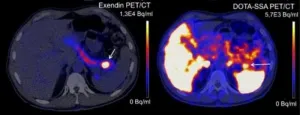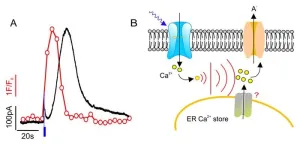(Press-News.org)
Microbes in the environment, not fossil fuels, have been driving the recent surge in methane emissions globally, according to a new, detailed analysis published Oct 28 in the Proceedings of the National Academy of Sciences by CU Boulder researchers and collaborators.
“Understanding where the methane is coming from helps us guide effective mitigation strategies,” said Sylvia Michel, a senior research assistant at the Institute of Arctic and Alpine Research(INSTAAR) and a doctoral student in the Department of Atmospheric and Oceanic Sciences at CU Boulder. “We need to know more about those emissions to understand what kind of climate future to expect.”
Methane is a potent greenhouse gas responsible for about a third of the planet’s warming since industrialization. Although the atmosphere contains less methane than carbon dioxide, methane traps about 30 times more heat than carbon dioxide over a 100-year time frame, making it a critical target for addressing climate change.
“Methane concentrations in the air have almost tripled since the 1700s,” said co-author Jianghanyang (Ben) Li, an assistant professor in the Department of Atmospheric and Oceanic Sciences and INSTAAR.
But unlike CO2, which can stay in the atmosphere for thousands of years, methane degrades within a decade. As a result, addressing methane emissions can have an immediate and powerful impact in slowing the rate of warming, making it a “low-hanging fruit,” Li said.
While the finding suggests microbes have been emitting more methane than fossil fuels in recent years, reducing fossil fuel consumption remains key to addressing climate change, the team said. Cutting down food waste and consuming less red meat can also help lower one’s methane footprint.
ID the source
Previous research suggests fossil fuel production is responsible for about 30% of global methane emissions.
But microbial sources—such as wetlands, cattle and landfills— are an even more significant source of methane, accounting for more than half of global emissions. Archaea, a type of microorganism living in soil and the guts of cows, produce methane as a byproduct of breaking down organic matter.
Michel and Li have been working with Boulder’s Global Monitoring Laboratory (GML) at the National Oceanic and Atmospheric Administration (NOAA) over the past years.
The lab receives air samples from 22 sites around the world every week or two. Researchers then isolate different components of the air—such as CO2 or methane—for analysis. By examining the types of carbon atoms, or isotopes, that the methane sample contains, Michel, Li and the team can identify its source. For example, methane from fossil fuels has more carbon-13 isotope than methane in the air, and methane from microbial sources contains even less carbon-13. The lab has been measuring isotopes of methane since 1998.
Scientists have observed a rapid increase in atmospheric methane levels since 2007, following a period of stabilization in the early 21st century. In 2020, NOAA reported the highest growth rate of methane since it began collecting data in 1983, and that record was shattered again in 2021.
At the same time, Michel noticed a surprising decrease in the carbon-13 isotope over the past 17 years. She and the team set out to understand what was driving it.
The culprit
Using computer simulations, Michel and her team modeled three different emissions scenarios to see which one would leave an isotopic signature similar to the one observed.
They found that between 2020 and 2022, the drastic increase in atmospheric methane was driven almost entirely by microbial sources. Since 2007, scientists have observed microbes playing a significant role in methane emissions, but their contribution has surged to over 90% starting in 2020.
“Some prior studies have suggested that human activities, especially fossil fuels, were the primary source of methane growth in recent years,” said Xin (Lindsay) Lan, a scientist at the Cooperative Institute for Research in Environmental Sciences (CIRES) at CU Boulder and NOAA. She leads the reporting on NOAA’s global greenhouse gas trends at the GML. “These studies failed to look at the isotope profile of methane, which could lead to a different conclusion and an incomplete picture of global methane emissions.”
It remains unclear whether the increased microbial emissions came from natural sources like wetlands or human-driven sources, such as landfills and agriculture. The team plans to delve deeper to identify the exact source of methane.
“In a warming world, it wouldn't be surprising if any of these sources emitted more methane,” said Michel, who explained that microbes, like humans, tend to have higher metabolism when it’s warm. “Consequently, more methane could stay in the atmosphere to accelerate global warming. So we need to address the climate crisis, and that really means addressing CO2 emissions.”
END
HERSHEY, Pa. — Immunotherapies that mobilize a patient’s own immune system to fight cancer have become a treatment pillar. These therapies, including CAR T-cell therapy, have performed well in cancers like leukemias and lymphomas, but the results have been less promising in solid tumors.
A team led by researchers from the Penn State College of Medicine has re-engineered immune cells so that they can penetrate and kill solid tumors grown in the lab. They created a light-activated switch that controls protein function associated with cell ...
The Arctic is threatened by strong climate change: the average temperature has risen by about 3°C since 1979 – almost four times faster than the global average. The region around the North Pole is home to some of the world’s most fragile ecosystems, and has experienced low anthropogenic disturbance for decades. Warming has increased the accessibility of land in the Arctic, encouraging industrial and urban development. Understanding where and what kind of human activities take place is key to ensuring sustainable development in the region – for both people and the environment. Until now, a comprehensive assessment of this part of the world has ...
A new PET scan reliably detects benign tumors in the pancreas, according to research led by Radboud university medical center. Current scans often fail to detect these insulinomas, even though they cause symptoms due to low blood sugar levels. Once the tumor is found, surgery is possible.
The pancreas contains cells that produce insulin, known as beta cells. Insulin is a hormone that helps the body absorb sugar from the blood and store it in places like muscle cells. This regulates blood sugar levels. In rare cases, the beta cells malfunction, resulting in a benign tumor called ...
During the late middle Pleistocene, between 300 and 400 thousand years ago, at least three ancient elephant relatives died near a river in the Kashmir Valley of South Asia. Not long after, they were covered in sediment and preserved along with 87 stone tools made by the ancestors of modern humans.
The remains of these elephants were first discovered in 2000 near the town of Pampore, but the identity of the fossils, cause of death and evidence of human intervention remained unknown until now.
A team ...
Mercouri Kanatzidis, a materials scientist at the U.S. Department of Energy’s Argonne National Laboratory and professor at Northwestern University, will receive the 2025 ACS Award in the Chemistry of Materials from the American Chemical Society, the nation’s leading professional organization of chemists.
The award “recognizes and encourages creative work in the chemistry of materials,” according to the citation.
At Argonne, Kanatzidis’s work has focused on the implications of a ...
When it comes to sustainable energy, harnessing nuclear fusion is—for many—a holy grail of sorts. Unlike climate-warming fossil fuels, fusion offers a clean, nearly limitless source of energy by combining light atomic nuclei to form heavier ones, releasing vast amounts of energy in the process.
But it isn’t easy replicating and controlling the process that powers the sun.
“We eventually want to move to producing energy this way,” says Brian Leard ’21 ’25G, a ...
Plants control their water consumption via adjustable pores (stomata), which are formed from pairs of guard cells. They open their stomata when there is a sufficient water supply and enough light for carbon dioxide fixation through photosynthesis. In the dark and in the absence of water, however, they initiate the closing of the pores.
SLAC/SLAH-type anion channels in the guard cells are of central importance for the regulation of the stomata. This has been shown by the group of Professor Rainer Hedrich, biophysicist at Julius-Maximilians-Universität ...
When it comes to building muscle, not all proteins are created equal.
New research from the University of Arkansas for Medical Sciences (UAMS) reveals that 100% ground beef packs a bigger punch for muscle protein synthesis than a soy-based counterpart. In fact, the study suggests that a person would need double the amount of soy-based protein to achieve the same results.
Published in the American Journal of Clinical Nutrition, the study examined the anabolic response — how the body builds muscle — after consuming a 4-ounce beef patty versus one or two 4-ounce patties of a soy-based product. The results? Just one serving of beef did the ...
A pilot study led by researchers at University of California San Diego School of Medicine found that advanced artificial intelligence (AI) could potentially lead to easier, faster and more efficient hospital quality reporting while retaining high accuracy, which could lead to enhanced health care delivery.
The study results, published in the October 21, 2024 online edition of the New England Journal of Medicine (NEJM) AI, found an AI system using large language models (LLMs) can accurately process hospital quality measures, ...
Four University of Michigan faculty have been elected to the National Academy of Medicine, one of the highest honors in medical research.
Kenneth M. Langa, M.D., Ph.D., Erica E. Marsh, M.D., MSCI, FACOG, Santa J. Ono, Ph.D. and Marc A. Zimmerman, Ph.D., are among 100 newly elected health and medical scientists recognized for their outstanding professional achievement and commitment to service.
They join the 79 other current, former and late U-M faculty who have earned this distinction. NAM members help the Congressionally chartered, private nonprofit organization provide objective advice to the nation on key health ...





